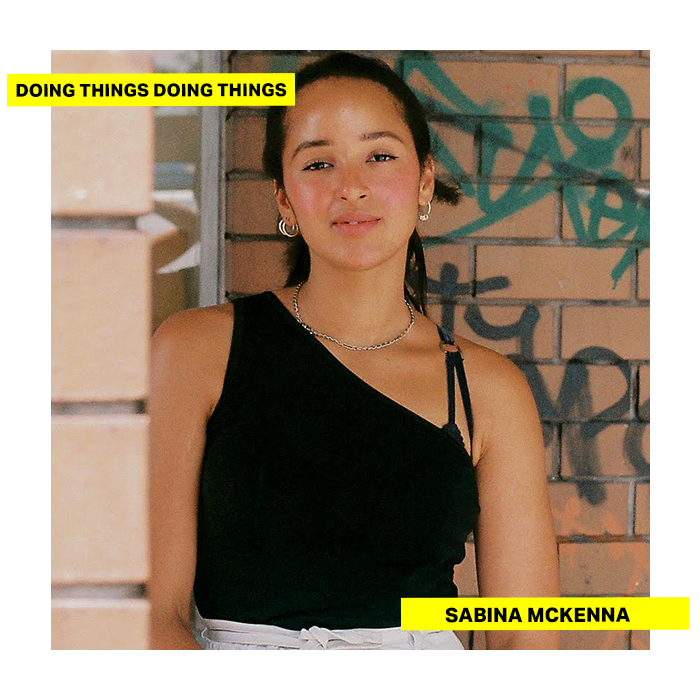DOING THINGS is an interview series putting the spotlight on young people who are doing cool, impactful stuff to make their corner of the world that little bit better. Read, get, inspired, and go do the things.
There’s little Sabina McKenna can’t do. On top of writing, modelling and marketing, the 28-year-old Melburnian curates art that digs deep on race, identity and belonging.
Her debut exhibition ‘Where Are You From?’ was a reflection on how nasty those four words are for the POC community. Using portraits and intimate reflections, ‘Where Are You From’ received a cathartic response in both her home city and Sydney.
“One big aspect of the feedback was people thanking me for creating that space,” McKenna says of her project from 2018. “There were so many tears in the room and so much emotion.”
“The recognition is what made me keep going because I know there’s a need for it. That means a lot that I can do that for other people.”

Now she’s back and armed through social media to deliver her latest project ‘Hair’, an online gallery and zine that celebrates curls and afro-textures.
This time, McKenna’s team chose window frames so the audience feels like they’re looking into the stories shared, coupled with VHS snippets for a touch of magic.
“I wanted to showcase the experiences that women of colour have with their hair,” she says.
“Our hair is very political and it can determine the way we’re perceived day-to-day and at work. We navigate that every time we go out into a space wearing natural hair or wearing a traditionally African hairstyle.”
What ties women of colour together, despite our different backgrounds, is learning to undo a lifetime of being made to feel like an ‘other’ – something Sabina herself has had to overcome. “From a really young age I was aware of there being something different about me. I was the only brown person in most spaces I navigated and that continued into my early adulthood.”
“When I was a child it kind of felt like there was something special about me and that was a very innocent understanding I had of it,” Sabina says. “My mum used to tell me about when I was four or five, running up to her with a magazine and pointing to this one little brown girl and being like, ‘Mum this is me!’”
“That’s just an example of how little representation there was out there. I think I still kind of have that experience now when I see other mixed race people. There’s just something in me that is warmed.”
Surrounded by Eurocentric beauty standards and systemic racism, that sense of specialness began to dwindle as she felt the pressure to conform her looks.
“Getting older, I spent a lot of years grappling with being different but thinking it was a negative or defective thing. I’d try to make myself more palatable by straightening my hair, staying out of the sun, wearing lighter foundation – not being aware of why I was doing it, just feeling the need to do it.”
Reflecting on her personal growth, Sabina realised the way to unlearn internalised biases was to share how empowered she feels about her hair now in hope that it would make others feel like they belong.
“I believed it was a burden for a lot of my life and I’d do everything that I could to change it,” she reflects. “Now, it’s a big part of me and it’s a really special thing that I’m learning more about even to this day. I probably only now know what my hair actually looks like naturally.”
Moving ‘Hair’ to Instagram (partly thanks to the pandemic) has been a blessing in disguise. The project has reached thousands of people from around the world and made her artwork accessible and shareable.
“A lot of people are like, ‘Oh my god, this is therapy!’ and then tag their friends in it. Or other people have been like, ‘What? Are you serious? You can’t go to the hairdresser? That’s crazy.’”
The natural hair movement in America has been underfoot since the 60s, but Australia is only just getting on board.
On top of being told that our hair isn’t desirable enough, women of colour still can’t access appropriate products or styling options here. Many are still turned away from the hairdressers because Afro-textured hair isn’t thoroughly taught in TAFE courses – a change a viral petition is seeking to fix.
“I’ve noticed that it’s actually becoming more of a thing where we are learning to do our own hair, and doing each other’s hair” Sabina says. “A lot of the [models from ‘Hair’], probably three or four of them, were hairstylists themselves.”
While we wait for society to embrace non-white tresses, ‘Hair’ begins at root of the conversation – through self love.
“Our hair is so powerful, beautiful and versatile. There’s so many historical and cultural things we can express with it. The more we talk about that, and the more we wear it proudly, the more we can change.”
“Also, it’s really fun. Like, our hair is fun!”
Scrolling through Insta and reading each model’s story makes us feel a little less alone and a little more seen – just as Sabina intended.
“I hope that someone like my former self, who was on this journey to accept and understand their hair could look at the work and think ‘Wow, people think my hair is beautiful enough to make this artwork and write about it. That must mean something really special about my hair!’”
And there is.
You can catch ‘Hair’ the Where Are you From? Instagram or grab her zine from the ‘Where Are You From?’ site.
